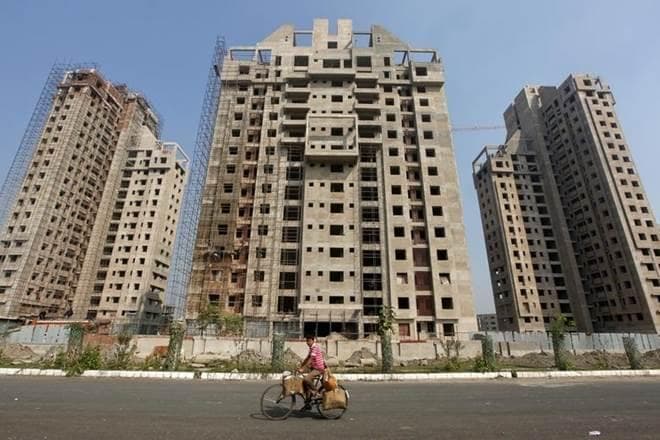Largely Mumbai-centric, Sunteck constructs luxury and ultra-luxury residential and commercial property. Its strong balance sheet, 25 city centric diversified projects and four rented assets (comprising 23m sq.ft.) provide strong revenue assurance for 4-5 years. Its recent QIP raised Rs 5 bn; the promoter infused another Rs 1.5 bn. Its post-QIP net D/E (0.1x) would fund the capex required. Its operations encompass Mumbai’s key micro-markets (south-central, suburban), the major ones being BKC and ODC. Besides, it has works in Goa, Nagpur and Jaipur. With an upcoming project in Dubai it is also expanding internationally.
High value of ready and nearly-complete inventory
High-value ready inventory at most-sought-after locations suggests that Sunteck is set to emerge as a key beneficiary of any positive delta in consumer sentiment. With a large part of costs already incurred, any liquidation of this inventory could accelerate cash-flow generation. The company sits on huge ready inventory of 0.5m sq.ft. (Rs 27 bn) and nearly complete inventory of 1.3 m sq.ft. (Rs 19.5 bn).
Striving to bring stability
Its plans for a rental portfolio of 2.6m sq.ft in Oshiwara appear a step in the right direction as relatively stable rental income would guard it from downsides in bad times. We believe the rental portfolio would generate `0.8 bn by FY23 and Rs 3.8 bn on 75% occupancy by FY25. Recent fund-raising (Rs 6.5 bn) is a key positive as access to capital could benefit the company in the distressed environment now. We see it judiciously using the cash available to enhance shareholder net worth.
Valuation
The stock trades at 1.8x FY20e P/BV. Considering Sunteck’s (i) strong cash-flow visibility, (ii) better leverage (post-QIP net D/E: 0.1x) and (iii) land-bank quality, its scrip quotes at attractive valuations. We are enthused about its growth prospects and initiate coverage with a Hold rating and a target price of Rs 467 (exit PBV of 2x FY20e). Risks: Delay in execution of new projects, slower-than-expected traction in BKC projects, economic slowdown.

Good at identifying land parcels; funded, supported by credible partners
Sunteck has had a strong record of identifying, for future growth, pieces of land with clean and clear titles and of securing funding through credible partners such as the India REIT Fund backed by the Ajay Piramal Group (APG) and the Kotak Real Estate Fund (KREF). For instance, it was one of the very few that bought from the Mumbai Metropolitan Region Development Authority (MMRDA) in 2006 for Rs 144 m a (two-acre) plot in the BKC for development of residential accommodation. This contrasted with others who were buying plots there to develop them for commercial purposes. Today, it has emerged as one of the luxury/premium residential developers in the BKC, where realisations have precipitously climbed within a decade from Rs 10,000-12,000 a sq.ft. to Rs 5,000-55,000.
The BKC deal
Investing only Rs 70 m, Sunteck roped in India REIT as bridge financier. The latter invested Rs 630 m, the balance Rs 700 m being debt funded. In the deal, it obtained 60% equity (sweat equity 50%, equity contribution 10%); India REIT secured 40%. Over the years, Sunteck’s share rose to 87.5% through a sponsor-promoter structure and buyback.
The Goregoan-ODC deal
In 2010-12, it acquired for Rs 4,258 m 23 acres at Rs 185 m each, securing contiguous land from different owners. In terms of funding of Rs 3,000 m for a further 16 acres, it again roped in KREF, which invested Rs 1,500 m; the balance was funded through internal accruals and sales collections. These transactions demonstrate the company’s ability to identify attractive land parcels for future growth and to fund their development through credible partners, thereby ensuring growth through an asset-light model. Besides this, it has 14.8m sq.ft. under the joint-venture/joint-development (JV/JD) model, largely through the Sunteck Piramal JV. Overall, 65% of its 22.6m sq.ft. is on the JV/JD model. Even on the remaining 35% of owned land, 88% was initially funded through credible partners such as KREF and India REIT. This demonstrates management’s focus on an asset-light model and in refraining from investing in land and blocking capital.
Affordable housing — To add to the potential
In the Union Budget 2017-18, infrastructure status was accorded to affordable housing, giving real-estate developers access to low-cost debt. Besides, the tax exemption for affordable-housing projects has been revised, the size of houses under Sec. 80–IBA (the Affordable-Housing Scheme) has been increased from 30-60 sq.mt. built-up area to 30-60 sq.mt. carpet area and the project-completion period has been extended from three to five years. All these measures by the government have made affordable-housing projects more attractive to developers and would help the government achieve its ‘Housing-for-All’ target by 2022. Sunteck broke from its conventional path of luxury and ultra-luxury projects to make a foray into the affordable housing sub-segment through its new brand “Aspirational Mid-Income Value Homes”, under a new division. To broaden its operations in different locations within the Mumbai Metropolitan Region (MMR), Sunteck will take full advantage of the Pradhan Mantri Awas Yojana (PMAY).


